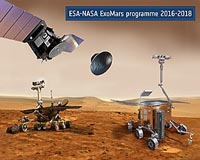 |
Montreal, Canada (SPX) Jun 07, 2010 Researchers at McGill's department of natural resources, the National Research Council of Canada, the University of Toronto and the SETI Institute have discovered that methane-eating bacteria survive in a highly unique spring located on Axel Heiberg Island in Canada's extreme North. Dr. Lyle Whyte, McGill University microbiologist explains that the Lost Hammer spring supports microbial life, that the spring is similar to possible past or present springs on Mars, and that therefore they too could support life. The subzero water is so salty that it doesn't freeze despite the cold, and it has no consumable oxygen in it. There are, however, big bubbles of methane that come to the surface, which had provoked the researchers' curiosity as to whether the gas was being produced geologically or biologically and whether anything could survive in this extreme hypersaline subzero environment. "We were surprised that we did not find methanogenic bacteria that produce methane at Lost Hammer," Whyte said, "but we did find other very unique anaerobic organisms - organisms that survive by essentially eating methane and probably breathing sulfate instead of oxygen." It has been very recently discovered that there is methane and frozen water on Mars. Photos taken by the Mars Orbiter show the formation of new gullies, but no one knows what is forming them. One answer is that there could be that there are springs like Lost Hammer on Mars. "The point of the research is that it doesn't matter where the methane is coming from," Whyte explained. "If you have a situation where you have very cold salty water, it could potentially support a microbial community, even in that extreme harsh environment." While Axel Heiberg is already an inhospitable place, the Lost Hammer spring is even more so. "There are places on Mars where the temperature reaches relatively warm -10 to 0 degrees and perhaps even above 0 degrees C," Whyte said, "and on Axel Heiberg it gets down to -50, easy. The Lost Hammer spring is the most extreme subzero and salty environment we've found. This site also provides a model of how a methane seep could form in a frozen world like Mars, providing a potential mechanism for the recently discovered Martian methane plumes."
Share This Article With Planet Earth
Related Links McGill University Mars News and Information at MarsDaily.com Lunar Dreams and more
 Detecting Clues For Alien Existence
Detecting Clues For Alien ExistenceLeicester, UK (SPX) Jun 03, 2010 University of Leicester scientists have announced the start of work, in collaboration with industry, on advanced instruments for ExoMars- a new mission to Mars in 2018. A development model of the Mars Rover, called Bridget, was on display at the University providing invited schoolchildren as well as staff and students with an exciting glimpse into the shape of things to come. The eve ... read more |
|
| The content herein, unless otherwise known to be public domain, are Copyright 1995-2010 - SpaceDaily. AFP and UPI Wire Stories are copyright Agence France-Presse and United Press International. ESA Portal Reports are copyright European Space Agency. All NASA sourced material is public domain. Additional copyrights may apply in whole or part to other bona fide parties. Advertising does not imply endorsement,agreement or approval of any opinions, statements or information provided by SpaceDaily on any Web page published or hosted by SpaceDaily. Privacy Statement |